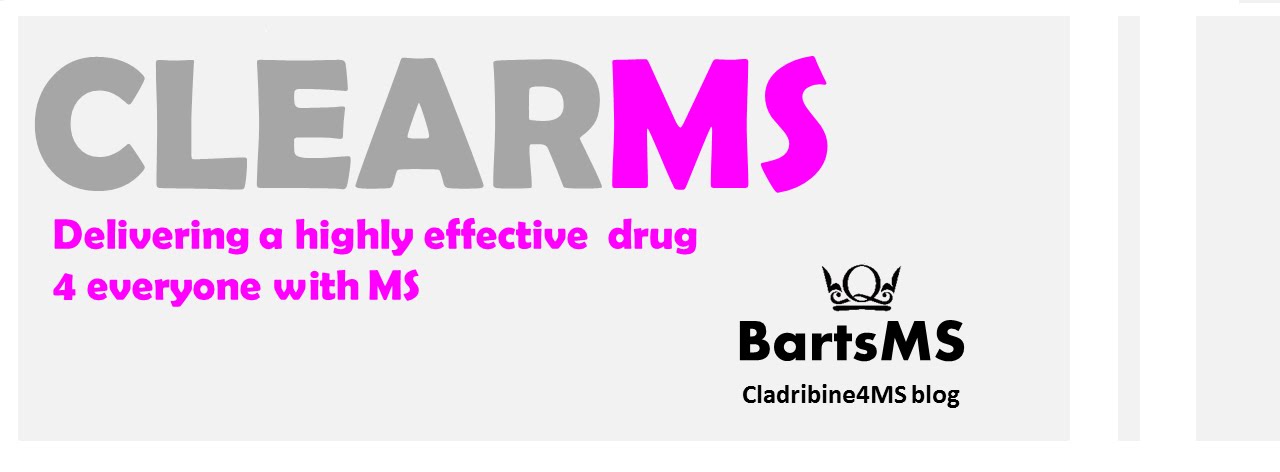Now that our hopes of a UK trial of Cladribine in relapsing MS have been dashed, it is time to move on and get something positive from all this effort.
Currently, Big Pharma is mainly interested in Relapsing MS. Academia, at least in the UK, are focussing their effort on ambulatory people with MS.
Can we do something for the forgotten thousands, those with deteriorating MS (what is "progressive" about worsening MS?), who are wheel chair users most or all of the time?
We know that
- MS is associated with the accumulation of damaging white blood cells (lesions) within the CNS.
- Lesions in people with relapsing and deteriorating ("progressive") MS are similar.
- People with deteriorating MS (pwDMS) have inflammatory and smouldering lesions.
- Modulation of the peripheral immune response blocks relapsing MS and the formation of new lesions.
- Many pwDMS develop new lesions and have relapses.
- pwDMS who display disease activity on MRI respond to peripheral immunodulation with current DMT.
- pwDMS may respond to central neuroprotection.
- Optimum therapy will likely mean control of immunity plus neuroprotection and repair.
Current DMT are too expensive and are not considered cost-effective for pwDMS and so DMT is withdrawn.
- Current trials in pwDMS are focussed (fixated?) on the EDSS as an outcome. This non-linear scale is heavily biased towards lower limb function.
- Deteriorating MS as measured by EDSS due to smouldering lesions is not responsive to peripheral immuno-modulation by the time it is tested.
- The longer the distance the nerve signal has to travel the more likely it will hit by MS lesions. One hypothesis therefore goes that the bladder and lower limbs are more likely to be damaged before the upper limbs.
- pwDMS have evidence of B cell activity within their brains that may cause grey matter lesions. They can produce antibodies that may be damaging in MS. No current drug works in the CNS to tackle this problem.
- Most importantly: pwDMS who have lost most or all of their lower limb function, will wish to maintain their upper limb function for mobility!
pwDMS who are in wheel chairs (i) have virtually no access to DMT and (ii) are excluded from clinical trials of drugs against deteriorating ("progressive") MS.
They are the forgotten thousands. People in wheel chairs have active lesions and progress and loose upper limb function.
- However, many pwDMS in wheelchairs may indeed respond to DMT.
- As their neural reserve of lower limb function may be lost pwDMS may not respond in terms of EDSS to peripheral immunomodulation with DMT.
- However, upper limb function is vital to everyone with MS, including those in wheelchairs and this neural reserve must be saved.
- Upper limb function may still respond to potent peripheral DMT:
The data from the ASCEND trial provide evidence that upper limb deterioration can be halted in pwDMS, whilst lower limb function continued to deteriorate. Other studies may not show this because the DMT are not good enough to stop active disease.
- Most companies making peripheral DMT have been burned by failures in progressive MS and may not risk further trials.
- People in wheelchairs are ignored as far as DMT goes.
Cladridine inhibits Active Lesion Formation. Gadolinium enhancing lesions drop by over 90%. Fewer lesions means less damage and reduced risk of deterioration
Cladribine inhibits relapses (annual relapse rate decreased to about 0.1 = one every ten years). Fewer relapses means less damage and reduced risk of deterioration.
Cladribine induces NEDA-3 in nearly 50% of people with a 1 year course of treatment.
Cladribine will be of value to slow the accumulation of damage in anyone with active MS... This means it should be of value for everyone with MS.
A cost-effective drug means everyone with active MS could have access to treatment.
Cladribine has the potential to save upper limb function via inhibition of peripheral immunity as it probably is as active as Natalizumab.
Cladribine enters the central nervous system and can kill dividing and non-dividing white blood cells, and it can kill plasma cells and can in some instances get rid of oligoclonal antibody bands. If these are causing grey matter lesions or even deterioration, it will target these mechanisms unlike any other MS drugs including ocrelizumab.
Cladribine is an induction treatment, thus it can act as a platform for layering on neuroprotection and repair agents.
Are you interested in a study for pwDMS who are wheel chair users?
If so, what should we call the trial?



































